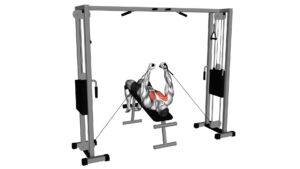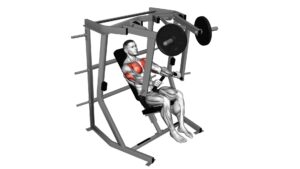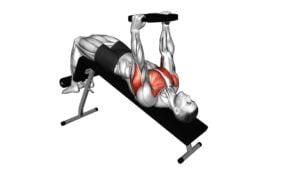Cable Decline Press – Video Exercise Guide & Tips

Looking to amp up your chest workout? The Cable Decline Press is here to help. In this video exercise guide, we'll show you the proper form and technique to maximize your results.
Watch This Exercise Video
With variations to challenge your muscles and tips to avoid common mistakes, you'll be on your way to a stronger, more defined chest in no time.
So grab those cables and get ready to press your way to greatness!
Key Takeaways
- Cable decline press is an effective way to target and strengthen chest muscles.
- Proper form and technique, such as maintaining a stable bench position and engaging core muscles, are crucial for maximizing benefits and minimizing the risk of injury.
- There are various variations of cable decline press that can be used to challenge different muscle groups and increase workout intensity.
- To maximize results, it is important to maintain a neutral spine, control the movement, vary the resistance, and support workouts with proper nutrition and recovery strategies.
Benefits of Cable Decline Press
Get ready to experience the numerous benefits of the cable decline press, as it provides an effective and efficient way for you to target and strengthen your chest muscles.
The cable decline press technique involves lying on a decline bench and grasping the cable handles attached to the weight stack. By pushing the handles away from your body while keeping your elbows slightly bent, you engage your chest muscles to perform the exercise.
This exercise variation is particularly beneficial because it allows for a greater range of motion compared to traditional decline bench presses with free weights. Additionally, the cable resistance provides constant tension throughout the movement, leading to increased muscle activation and growth.
One of the key advantages of the cable decline press is its versatility. You can modify the exercise by adjusting the height of the cable handles, allowing you to target different areas of your chest muscles. Lowering the handles to the bottom position emphasizes the lower chest, while raising them to the top position places more emphasis on the upper chest. This flexibility allows you to customize your workout based on your specific goals and muscle imbalances.
Now that you understand the benefits of the cable decline press, let's move on to discussing proper form and technique to maximize your results.
Proper Form and Technique
To perform the cable decline press with proper form and technique, follow these guidelines:
- Maintain a stable bench position: Ensure that the bench is securely set at a decline angle, providing a stable base for your exercise.
- Engage your core: Throughout the movement, engage your core muscles by tightening your abdominal muscles. This will help maintain stability and prevent your lower back from arching.
- Control the weight: Slowly lower the handles towards your chest, keeping your elbows slightly bent. Avoid letting the weight drop quickly, as this can lead to injury.
It's important to note some common mistakes that people make when performing the cable decline press. One of these is using too much weight, which can compromise your form and lead to improper technique.
Another mistake is failing to maintain a stable bench position, which can increase the risk of injury.
Lastly, not engaging your core muscles can result in an unstable movement and reduced effectiveness of the exercise.
By following these proper techniques, you can maximize the benefits of the cable decline press and minimize the risk of injury.
Now let's explore some variations to challenge your muscles.
Variations to Challenge Your Muscles
To challenge your muscles, try incorporating different variations of the cable decline press exercise. By making modifications to the traditional cable decline press, you can target specific muscle groups and increase the intensity of your workout.
One modification you can try is the single-arm cable decline press. This variation requires you to use only one arm at a time, which engages your core muscles for stability and increases the demand on your chest and triceps.
Another advanced technique is the staggered stance cable decline press. By positioning one foot slightly in front of the other, you create an unstable base, forcing your muscles to work harder to maintain balance. This variation not only targets your chest and triceps but also activates your core and leg muscles.
Additionally, you can incorporate resistance bands into your cable decline press routine. By attaching resistance bands to the cable machine, you add extra resistance throughout the movement, challenging your muscles even further.
Remember to start with lighter weights and gradually increase the intensity as you become more comfortable with these advanced techniques.
Tips to Maximize Your Results
To maximize your results with the cable decline press, focus on proper form and technique. Here are some tips to help you get the most out of this exercise:
- Maintain a neutral spine: Keep your back flat against the bench and avoid arching or rounding your back. This will engage your core muscles and protect your spine.
- Control the movement: Slowly lower the cables and press them back up, focusing on the contraction of your chest muscles throughout the exercise. Avoid using momentum to lift the weight.
- Vary the resistance: Adjust the weight on the cable machine to challenge yourself. Start with a weight that allows you to perform 8-12 reps with proper form, and gradually increase the resistance as you get stronger.
In addition to proper form and technique, it's important to support your workouts with proper nutrition and recovery strategies. Make sure to fuel your body with a balanced diet that includes lean proteins, complex carbohydrates, and healthy fats. Stay hydrated and consider incorporating supplements like protein powder to aid in muscle recovery. Prioritize rest days to allow your muscles to repair and grow. Stretching and foam rolling can also help with muscle recovery and prevent injuries.
Common Mistakes to Avoid
Avoid these common mistakes to get the most out of your cable decline press exercise.
Proper breathing and using the right equipment are essential for a successful workout.
One common mistake isn't maintaining proper breathing technique during the exercise. It's important to exhale as you push the cables away from your body and inhale as you bring them back in. This will help you engage your core and stabilize your body throughout the movement.
Another mistake to avoid is using improper equipment. Make sure you're using a decline bench that's sturdy and adjustable to the desired angle. The cables should be securely attached and in good condition. Using worn-out or damaged cables can lead to accidents and injuries.
Additionally, it's crucial to use the appropriate weight for your fitness level. Starting with a weight that's too heavy can compromise your form and increase the risk of injury. Conversely, using a weight that's too light may not challenge your muscles enough to make progress.
Frequently Asked Questions
How Many Sets and Reps Should I Do for the Cable Decline Press?
For the cable decline press, it's important to consider the number of sets and reps that work best for you. Start with 3 sets of 8-12 reps, focusing on proper form and control.
This exercise targets your chest, shoulders, and triceps while also engaging your core for stability.
By following a consistent routine and gradually increasing the weight, you can experience the benefits of building strength and muscle.
Avoid common mistakes like using too much weight or arching your back excessively.
Can I Perform the Cable Decline Press if I Have Lower Back Issues?
If you have lower back issues, it's important to be cautious when performing the cable decline press. Putting strain on your lower back could worsen your condition.
It would be best to consult with a healthcare professional or a qualified trainer who can assess your situation and provide modifications or alternative chest exercises that won't put pressure on your lower back.
Safety should always be your top priority when working out.
Should I Use a Lighter or Heavier Weight for the Cable Decline Press?
When deciding on the weight for the cable decline press, consider your current fitness level and goals.
Using a lighter weight can help with focusing on form and technique, especially if you're new to the exercise or working on improving your form. It allows you to practice the movement correctly without sacrificing control.
However, if you're more experienced and looking to challenge your muscles, using a heavier weight can provide a greater stimulus for strength and muscle growth.
Is It Necessary to Warm up Before Doing the Cable Decline Press Exercise?
It is important to warm up before doing the cable decline press exercise.
Dynamic warm up exercises have many benefits, such as increasing blood flow to the muscles and improving flexibility.
Warming up prepares your body for the workout ahead and reduces the risk of injury.
Additionally, proper form is crucial in the cable decline press to target the intended muscles and avoid strain.
Can I Substitute the Cable Decline Press With Another Chest Exercise?
Yes, you can substitute the cable decline press with other chest exercises.
There are several alternative exercises that target the chest muscles effectively, such as the dumbbell bench press, push-ups, or chest dips.
These exercises can provide similar benefits to the cable decline press and help you build strength and muscle in your chest.
It's important to choose exercises that align with your fitness goals and preferences.
Consulting with a fitness professional can help you determine the best alternative exercises for your specific needs.
Conclusion
Overall, the cable decline press is a valuable exercise for targeting your chest muscles and improving upper body strength.
By maintaining proper form and technique, you can maximize the benefits and avoid common mistakes.
Incorporating variations into your routine will challenge your muscles and prevent plateaus.
Remember to prioritize safety and consult a fitness professional if needed.
With consistency and dedication, you can achieve great results from this exercise.

Author
Years ago, the spark of my life’s passion ignited in my mind the moment I stepped into the local gym for the first time. The inaugural bead of perspiration, the initial endeavor, the very first surge of endorphins, and a sense of pride that washed over me post-workout marked the beginning of my deep-seated interest in strength sports, fitness, and sports nutrition. This very curiosity blossomed rapidly into a profound fascination, propelling me to earn a Master’s degree in Physical Education from the Academy of Physical Education in Krakow, followed by a Sports Manager diploma from the Jagiellonian University. My journey of growth led me to gain more specialized qualifications, such as being a certified personal trainer with a focus on sports dietetics, a lifeguard, and an instructor for wellness and corrective gymnastics. Theoretical knowledge paired seamlessly with practical experience, reinforcing my belief that the transformation of individuals under my guidance was also a reflection of my personal growth. This belief holds true even today. Each day, I strive to push the boundaries and explore new realms. These realms gently elevate me to greater heights. The unique combination of passion for my field and the continuous quest for growth fuels my drive to break new ground.







